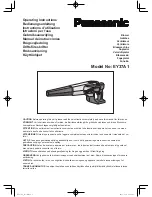
2
WARNING signals a hazard that may cause serious
injury or death if the recommended precautions are
not followed.
CAUTION signals a hazard that may cause minor or
moderate injury if the recommended precautions are
not followed.
Two other words are also used to highlight
information. “Important” calls attention to special
mechanical information and “Note” emphasizes
general information worthy of special attention.
The left and right side of the machine is determined
by standing behind the handle in the normal
operator’s position.
Safety
The 724 SNOWTHROWER meets or exceeds the
Outdoor Power Equipment Institute’s safety
standards for snowthrowers; thus, Toro proudly
displays the OPEI safety seal. To ensure maximum
safety, best performance, and to gain knowledge of
the product, it is essential that you or any other
operator of the snowthrower read and understand
the contents of this manual before the engine is
ever started. Pay particular attention to the safety
alert symbol
which means CAUTION,
WARNING OR DANGER — “personal safety
instruction.” Read and understand the instruction
because it has to do with safety. Failure to comply
with instruction may result in personal injury.
The following instructions are comparable to the
Instructions For Safe Snowthrowing adopted by the
American National Standards Institute (ANSI). The
snowthrower is designed and tested to offer
reasonably safe service; however, failure to comply
with the following instructions MAY RESULT IN
PERSONAL INJURY.
Before Operating
1.
Read and understand the contents of this manual
before operating the snowthrower. Become
familiar with all controls and know how to stop
the engine quickly.
2.
Keep everyone, especially children and pets,
away from snowthrower and area of operation.
Never allow children to operate the
snowthrower. Adults should operate the
snowthrower only after reading this manual.
3.
Thoroughly inspect area where snowthrower will
be used. Remove doormats, sleds, boards, sticks,
wire, and any other foreign objects which might
be picked up and thrown by the snowthrower.
4.
Keep all shields and safety devices in place. If a
shield, safety device or decal is illegible,
damaged or lost, repair or replace it before
beginning operation. Also, tighten any loose
nuts, bolts or screws.
5.
Wear adequate winter clothing and rubber boots
that will ensure proper footing on slippery
surfaces. Do not wear loose fitting clothing that
could possibly get caught in moving parts.
6.
Always wear safety glasses or eye shields during
operation or while performing an adjustment or
repair to protect eyes from foreign objects that
may be thrown from the machine.
7.
Adjust both skids so auger housing clears gravel
or crushed rock surfaces.
8.
Before starting the engine, ensure auger drive
control and traction (wheel drive) control are in
disengaged position.
9.
Always use a grounded, three wire plug and cord
to start snowthrower equipped with an electric
starter. Extension cord must be connected to a
properly grounded outlet.
10. Fill fuel tank with gasoline before starting the
engine. Avoid spilling any gasoline. Because
gasoline is highly flammable, handle it carefully.
DO NOT SMOKE WHILE HANDLING
GASOLINE.












































